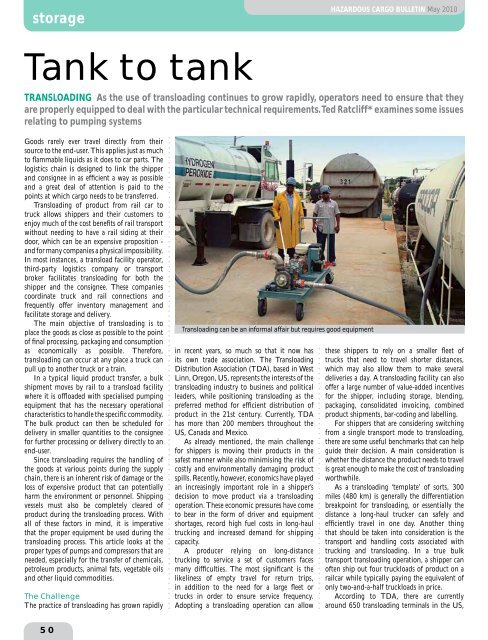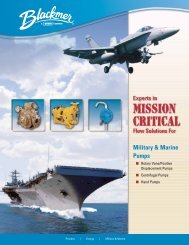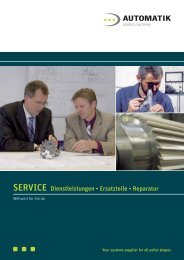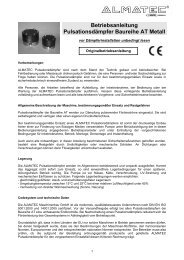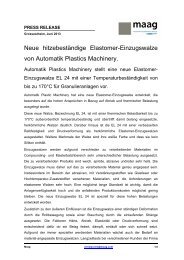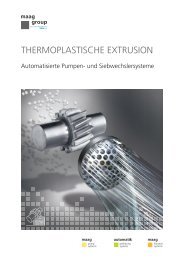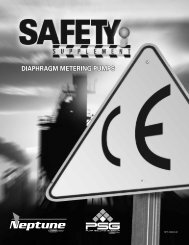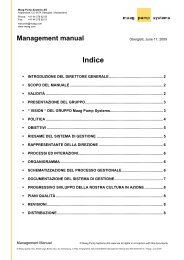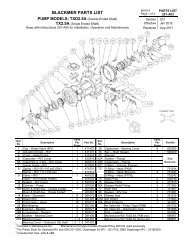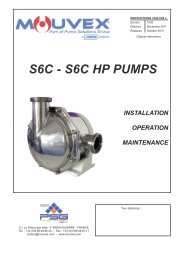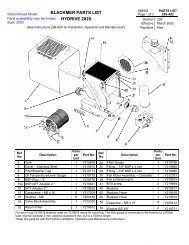storage - PSG Dover
storage - PSG Dover
storage - PSG Dover
Create successful ePaper yourself
Turn your PDF publications into a flip-book with our unique Google optimized e-Paper software.
<strong>storage</strong><br />
Tank to tank<br />
Goods rarely ever travel directly from their<br />
source to the end-user. This applies just as much<br />
to flammable liquids as it does to car parts. The<br />
logistics chain is designed to link the shipper<br />
and consignee in as efficient a way as possible<br />
and a great deal of attention is paid to the<br />
points at which cargo needs to be transferred.<br />
Transloading of product from rail car to<br />
truck allows shippers and their customers to<br />
enjoy much of the cost benefits of rail transport<br />
without needing to have a rail siding at their<br />
door, which can be an expensive proposition -<br />
and for many companies a physical impossibility.<br />
In most instances, a transload facility operator,<br />
third-party logistics company or transport<br />
broker facilitates transloading for both the<br />
shipper and the consignee. These companies<br />
coordinate truck and rail connections and<br />
frequently offer inventory management and<br />
facilitate <strong>storage</strong> and delivery.<br />
The main objective of transloading is to<br />
place the goods as close as possible to the point<br />
of final processing, packaging and consumption<br />
as economically as possible. Therefore,<br />
transloading can occur at any place a truck can<br />
pull up to another truck or a train.<br />
In a typical liquid product transfer, a bulk<br />
shipment moves by rail to a transload facility<br />
where it is offloaded with specialised pumping<br />
equipment that has the necessary operational<br />
characteristics to handle the specific commodity.<br />
The bulk product can then be scheduled for<br />
delivery in smaller quantities to the consignee<br />
for further processing or delivery directly to an<br />
end-user.<br />
Since transloading requires the handling of<br />
the goods at various points during the supply<br />
chain, there is an inherent risk of damage or the<br />
loss of expensive product that can potentially<br />
harm the environment or personnel. Shipping<br />
vessels must also be completely cleared of<br />
product during the transloading process. With<br />
all of these factors in mind, it is imperative<br />
that the proper equipment be used during the<br />
transloading process. This article looks at the<br />
proper types of pumps and compressors that are<br />
needed, especially for the transfer of chemicals,<br />
petroleum products, animal fats, vegetable oils<br />
and other liquid commodities.<br />
The Challenge<br />
The practice of transloading has grown rapidly<br />
50<br />
in recent years, so much so that it now has<br />
its own trade association. The Transloading<br />
Distribution Association (TDA), based in West<br />
Linn, Oregon, US, represents the interests of the<br />
transloading industry to business and political<br />
leaders, while positioning transloading as the<br />
preferred method for efficient distribution of<br />
product in the 21st century. Currently, TDA<br />
has more than 200 members throughout the<br />
US, Canada and Mexico.<br />
As already mentioned, the main challenge<br />
for shippers is moving their products in the<br />
safest manner while also minimising the risk of<br />
costly and environmentally damaging product<br />
spills. Recently, however, economics have played<br />
an increasingly important role in a shipper’s<br />
decision to move product via a transloading<br />
operation. These economic pressures have come<br />
to bear in the form of driver and equipment<br />
shortages, record high fuel costs in long-haul<br />
trucking and increased demand for shipping<br />
capacity.<br />
A producer relying on long-distance<br />
trucking to service a set of customers faces<br />
many difficulties. The most significant is the<br />
likeliness of empty travel for return trips,<br />
in addition to the need for a large fleet or<br />
trucks in order to ensure service frequency.<br />
Adopting a transloading operation can allow<br />
HAZARDOUS CARGO BULLETIN May 2010<br />
TRANSLOADING As the use of transloading continues to grow rapidly, operators need to ensure that they<br />
are properly equipped to deal with the particular technical requirements. Ted Ratcliff* examines some issues<br />
relating to pumping systems<br />
Transloading can be an informal affair but requires good equipment<br />
these shippers to rely on a smaller fleet of<br />
trucks that need to travel shorter distances,<br />
which may also allow them to make several<br />
deliveries a day. A transloading facility can also<br />
offer a large number of value-added incentives<br />
for the shipper, including <strong>storage</strong>, blending,<br />
packaging, consolidated invoicing, combined<br />
product shipments, bar-coding and labelling.<br />
For shippers that are considering switching<br />
from a single transport mode to transloading,<br />
there are some useful benchmarks that can help<br />
guide their decision. A main consideration is<br />
whether the distance the product needs to travel<br />
is great enough to make the cost of transloading<br />
worthwhile.<br />
As a transloading ‘template’ of sorts, 300<br />
miles (480 km) is generally the differentiation<br />
breakpoint for transloading, or essentially the<br />
distance a long-haul trucker can safely and<br />
efficiently travel in one day. Another thing<br />
that should be taken into consideration is the<br />
transport and handling costs associated with<br />
trucking and transloading. In a true bulk<br />
transport transloading operation, a shipper can<br />
often ship out four truckloads of product on a<br />
railcar while typically paying the equivalent of<br />
only two-and-a-half truckloads in price.<br />
According to TDA, there are currently<br />
around 650 transloading terminals in the US,
<strong>storage</strong><br />
with more in the works. TDA forecasts doubledigit<br />
growth in throughput by its members<br />
through to 2015. The average number of<br />
available railcar positions per transloading<br />
facility is 50. If these estimates are correct,<br />
then there is room for more than 32,000 tank<br />
cars to be unloaded at any one time. That full<br />
capacity will probably never happen, but these<br />
numbers do offer an idea of the potential size of<br />
the market. Using these estimates and assuming<br />
only a 60 per cent utilisation factor, each facility<br />
would require three to five pieces of off-loading<br />
equipment to keep up with demand. At the<br />
lowest level, that would be almost 2,000 units<br />
on the ground.<br />
With that said, while transloading may<br />
make the most sense for a shipper from both<br />
an economical and logistical standpoint, the<br />
world’s most efficient transloading operation<br />
will not function successfully if the pumping<br />
and compressor equipment needed to<br />
necessitate the transloading process does not<br />
work effectively.<br />
The solution<br />
Fortunately for the vast array of shippers who<br />
are implementing transloading operations,<br />
there is an easy solution to their producttransfer<br />
needs: the complete line of sliding<br />
vane pumps and reciprocating gas compressors<br />
from Grand Rapids, Michigan-based Blackmer.<br />
Part of <strong>Dover</strong> Corporation’s Pump Solutions<br />
Group (<strong>PSG</strong>), Blackmer is the global leader<br />
in transloading solutions since its sliding vane<br />
pumps and compressors are highly energyefficient<br />
and eliminate many of the maintenance<br />
concerns that are inherent in other pump and<br />
compressor styles.<br />
The versatility of Blackmer’s sliding vane<br />
technology is what makes these pumps ideal<br />
for transloading applications. Blackmer sliding<br />
vane pumps are self-priming, designed to run<br />
dry for short periods, and their high suction<br />
makes them ideal for line stripping. They are<br />
available in cast iron, ductile iron and stainless<br />
steel models with special elastomers that make<br />
them compatible with a wide array of products.<br />
For self-loading trucks, the pumps come with<br />
port sizes up to 4 inches and have maximum<br />
working pressures up to 175 psi (12.1 bar).<br />
They can reach speeds of 1,200 rpm with both<br />
PTO and hydraulic drive capabilities. For<br />
transloading applications that involve stationary<br />
and portable onsite pumps, by manifolding the<br />
railcars, the flow rates are basically only limited<br />
to the receiving capacity of the system. Certain<br />
lines of Blackmer sliding vane pumps are also<br />
available in a sealless design for applications<br />
that require zero shaft leakage.<br />
The vanes in a sliding vane pump slide freely<br />
52<br />
into or out of slots in the pump rotor. When the<br />
pump driver turns the rotor, centrifugal force,<br />
rods and/or pressurised fluid cause the vanes to<br />
move outwards in their slots and bear against<br />
the inner bore of the pump casing, forming<br />
pumping chambers. As the rotor revolves,<br />
fluid flows into the area between the vanes<br />
when they pass the suction port. This fluid is<br />
transported around the pump casing until the<br />
discharge port is reached. At this point the fluid<br />
is squeezed out into the discharge piping.<br />
This simple pumping principle, which has<br />
been an industry standard for more than a<br />
century, allows Blackmer’s sliding vane pumps<br />
to handle numerous types of products safely<br />
and efficiently. Among these are clean, noncorrosive<br />
industrial liquids and petroleum<br />
products; liquids ranging in viscosity from thin<br />
solvents to heavy oils; hazardous fluids; biofuels;<br />
non-lubricating solvents; highly viscous liquids<br />
or abrasive slurries; corrosive or caustic fluids;<br />
and inks, paints and adhesives.<br />
Blackmer’s reciprocating gas compressors<br />
have been designed particularly for liquefied<br />
gas transloading operations. A compressor<br />
draws vapour from the <strong>storage</strong> vessel and boosts<br />
the pressure into the top of the rail car. The<br />
increased pressure in the rail car and slightly<br />
decreased pressure in the <strong>storage</strong> vessel results<br />
in a pressure differential between the two tanks<br />
that will easily push the liquid from the rail car<br />
to <strong>storage</strong>. The result is fast and quiet liquid<br />
transfer with no NPSH or cavitation problems.<br />
These compressors are equipped with highefficiency<br />
valves, ductile-iron cylinders, selfadjusting<br />
piston rod seals and other robust<br />
features.<br />
Blackmer’s LB Series compressors not only<br />
evacuate a railcar or truck tank, they can recover<br />
vapours as well, equivalent to adding 3 per cent<br />
capacity to every load. They are available with<br />
transfer capacities ranging from 40 to 640<br />
gal/min (150-2,420 L/min). LB compressors<br />
are designed to handle transfer and recovery<br />
of propane, butane, LPG and anhydrous<br />
ammonia. Blackmer’s HD Series compressors<br />
can handle the transfer and recovery of carbon<br />
dioxide, refrigerants, sulphur dioxide, chlorine,<br />
vinyl chlorine, natural gas, nitrogen and other<br />
gases.<br />
Mobility aids<br />
The portability of Blackmer’s sliding vane<br />
pumps and compressors has also given many<br />
shippers and operators of <strong>storage</strong> facilities the<br />
option to create movable skids that allow the<br />
pumps and compressors to be shifted around<br />
a facility to perform transloading operations.<br />
These units can be placed between two railcars<br />
on a siding if product needs to be pumped<br />
HAZARDOUS CARGO BULLETIN May 2010<br />
Centering on Centrifugal<br />
Blackmer also has the answers for<br />
transloading operations that involve the<br />
use of centrifugal pumping technology.<br />
The design of Blackmer’s System One®<br />
Centrifugal Pumps makes them capable<br />
of pumping several thousand gallons of<br />
product per minute, which is a crucial<br />
consideration when multiple railcars<br />
need to be loaded or unloaded at one<br />
time. The System One pumps can meet<br />
these parameters because they have been<br />
designed around the seal and bearings,<br />
where 90 per cent of pump failures occur.<br />
Their heavy-duty, solid, low-deflection<br />
shaft prevents common vibration damage<br />
and allows greater stability at the seal area<br />
to improve seal life.<br />
out of one and into the other, or positioned<br />
between and truck and railcar to facilitate the<br />
transloading process.<br />
For an example of how effective a transloading<br />
operation featuring Blackmer pumps can be,<br />
consider the case of Seeler Industries. Seeler<br />
operates the 3 Rivers Terminal in Joliet, Illinois,<br />
which has 17 <strong>storage</strong> tanks and 15 blending<br />
tanks. It has become one of the Midwest’s<br />
leading storers, handlers and packagers of<br />
hydrogen peroxide, along with other industrial<br />
liquids like caustics, amines, glycerin propylene,<br />
glycol and chemical de-icers.<br />
The 3 Rivers Terminal is served by seven<br />
truck loading racks and 42 railcar unloading<br />
positions. These racks and railcar positions<br />
enable Seeler to offer transloading services to<br />
its customers. To optimise its transloading<br />
options, Seeler installed a series of Blackmer<br />
STX3 and SNP3J sliding vane pumps, which<br />
are ideal for use in terminal transfer applications<br />
because their stainless steel construction makes<br />
them compatible with the chemicals, solvents,<br />
caustics, sulfates and acids that the terminal<br />
handles on a regular basis.<br />
To increase its transloading options, Seeler<br />
also had a Blackmer SX3 sliding vane pump<br />
mounted on a portable cart that is moved<br />
wherever it is needed in the facility. This pump<br />
features a gear reducer that allows it to run at<br />
two speeds—90 to 100 gpm when offloading<br />
a railcar and 60 gpm for drum and tote filling.<br />
The pump’s engine drive also allows it to be<br />
used even when there is a power failure.<br />
*Ted Ratcliff is senior product specialist for Grand<br />
Rapids-based Blackmer, an operating company<br />
within <strong>Dover</strong> Corporation’s Pump Solutions<br />
Group (<strong>PSG</strong>). He can be reached at (+1 817) 460<br />
1369 or ratcliff@blackmer.com.


